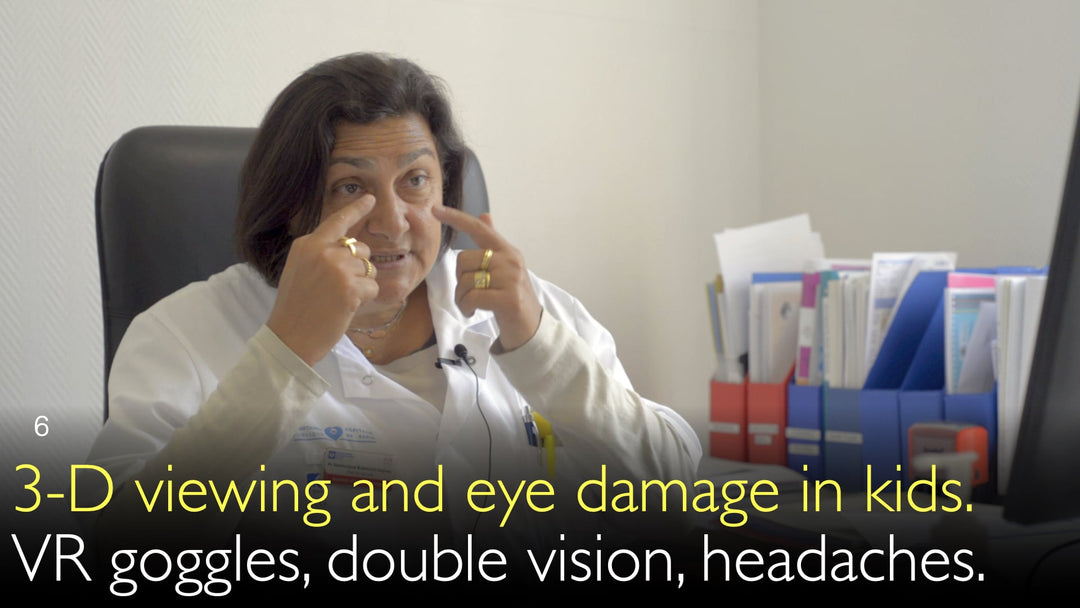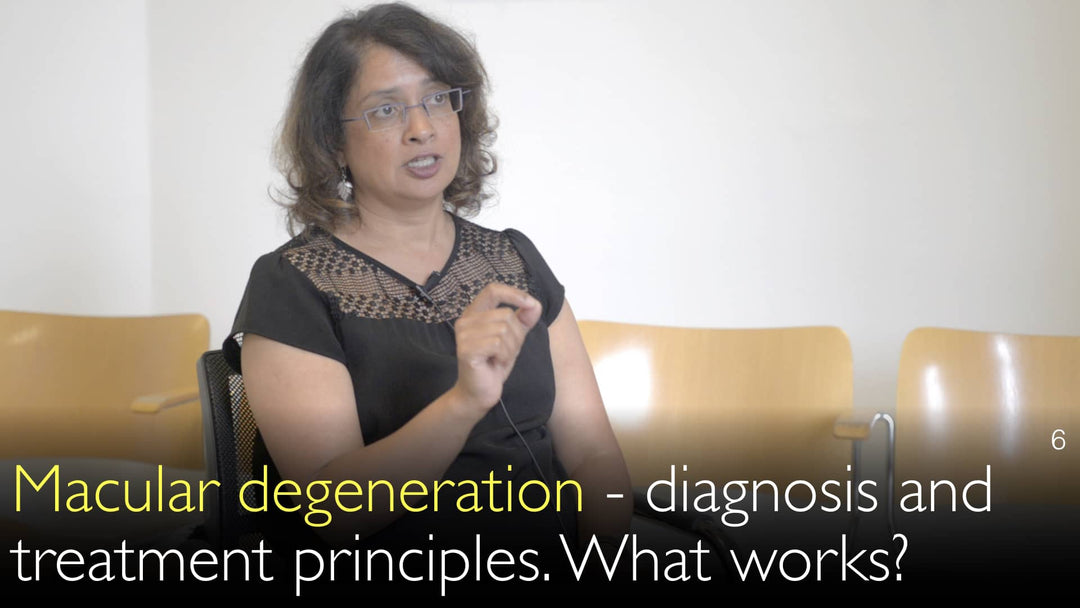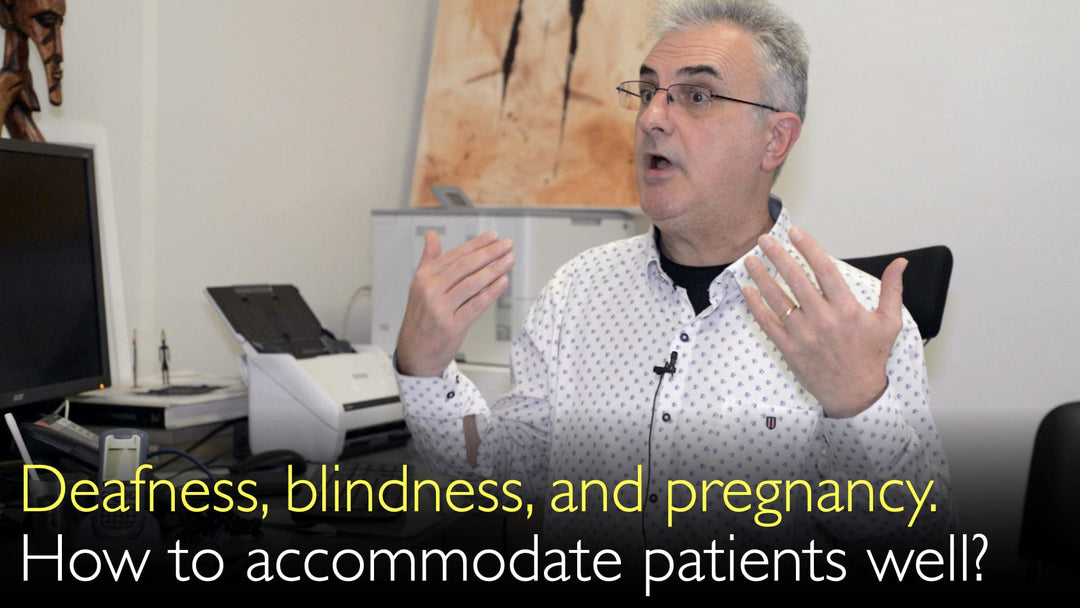Leading expert in pediatric ophthalmology, Dr. Dominique Bremond-Gignac, MD, explains how 3-D viewing technology like VR goggles and 3-D movies can damage developing eyes in children and adolescents, causing vergence insufficiency, headaches, and double vision. She details the global myopia pandemic linked to screen time, the mechanism of eye strain from 3-D dissociation, and the critical diagnostic steps for identifying and treating vergence disorders to prevent long-term visual and postural problems.
3-D Viewing and VR Eye Damage in Children: Headaches, Double Vision, and Treatment
Jump To Section
- 3-D and VR Eye Damage in Children
- Screen Time and the Myopia Pandemic
- Vergence Insufficiency Symptoms and Causes
- How 3-D Goggles Cause Dissociation Problems
- Diagnosing Vergence Insufficiency
- Vergence, Posture, and Dyslexia Link
- Full Transcript
3-D and VR Eye Damage in Children
3-D viewing options, including virtual reality goggles, headsets, and 3-D movies, are becoming ubiquitous, especially with the push toward a "metaverse." However, this technology poses a significant risk of eye damage, particularly in children and adolescents whose visual systems are still developing. As Dr. Dominique Bremond-Gignac, MD, explains, the primary concerns are the induction or exacerbation of vergence insufficiency, leading to symptoms like headaches and double vision.
Screen Time and the Myopia Pandemic
Excessive screen time is a primary driver of the global myopia pandemic. Dr. Dominique Bremond-Gignac, MD, notes that it is common to see very young children, even six-month-olds, interacting with smartphones. This early and prolonged exposure is a major concern. The scale of the problem is immense; in Singapore, for example, approximately 90% of young adults are now myopic, a drastic increase from just two decades ago. While screens are not the sole cause, they are a significant contributing factor that must be managed by drastically reducing usage time.
Vergence Insufficiency Symptoms and Causes
Vergence insufficiency is a common eye disorder, affecting an estimated 30% of the population. It occurs when the eyes have difficulty working together to focus on a near object. The use of 3-D screens can directly induce or worsen this condition. Symptoms are often non-specific but debilitating, including persistent headaches, double vision (diplopia), eye strain, dizziness, and a general feeling of visual instability. In children, these symptoms can manifest as poor school performance, as the child struggles to focus and read comfortably.
How 3-D Goggles Cause Dissociation Problems
The core problem with 3-D technology is the artificial dissociation it creates between vergence and accommodation. As Dr. Dominique Bremond-Gignac, MD, clarified for Dr. Anton Titov, MD, normally when you look at a nearby object like your finger, your eyes converge (turn inward) and your lenses accommodate (focus) simultaneously. 3-D goggles break this natural link; your eyes remain looking straight ahead at a screen, but the software tricks your brain into perceiving depth and objects at different distances. This conflicting signal confuses the brain, placing immense strain on the ocular motor system and severely aggravating any pre-existing vergence insufficiency.
Diagnosing Vergence Insufficiency
Diagnosing vergence insufficiency requires a comprehensive eye examination that goes beyond a standard check for glasses. Dr. Dominique Bremond-Gignac, MD, emphasizes the necessity of a full orthoptic examination to assess ocular motility and how the eyes work together. A critical component is a cycloplegic refraction, where special eyedrops are used to temporarily paralyze the eye's focusing mechanism. This allows the ophthalmologist to obtain a true measurement of any refractive error, such as nearsightedness or farsightedness, that might be contributing to the problem. This multi-faceted approach is essential for a correct diagnosis.
Vergence, Posture, and Dyslexia Link
Vergence insufficiency has implications that extend beyond vision. Dr. Dominique Bremond-Gignac, MD, notes a clear connection between poor vergence and postural problems in children, as the body struggles to compensate for unstable binocular vision. Furthermore, there is a significant association between vergence insufficiency and other learning challenges, most notably dyslexia. A child who already struggles with reading will find the task exponentially more difficult if they are also coping with eye strain, headaches, and double vision from an undiagnosed vergence disorder. Identifying and treating the visual problem is therefore a crucial step in supporting a child's overall development and academic success.
Full Transcript
Dr. Anton Titov, MD: 3-D viewing options, virtual reality, 3-D movies, and virtual reality goggles and headsets are becoming more common. We are promised a "metaverse" now. But 3-D viewing causes potential damage to the eye, particularly in children and adolescents. How can 3-D view damage eyes of a young person?
Are problems with 3-D viewing limited only to a developing eye?
How to prevent accommodation and vergence problems in children?
Dr. Dominique Bremond-Gignac, MD: It is a very interesting question, also related to myopia, but also related to vergence insufficiencies. We live in a world where screens are part of life every day, even for the youngest of children. That's a big problem. Because we see today six-month-old children with a smartphone in their hand. They are just playing with a phone. That's a problem because it's too early, of course, for them to look at screens.
We know in China they just avoid screens until three years of age. Maybe we can go in between those extremes. But the problem is the consequence of these screens is going to be myopia. As we discussed myopia, there is a pandemic-related problem of myopia in children and adults.
We know that, for instance, in Singapore, probably about 90% of young adults are myopic. That's incredible. It was, of course, not this way 20 years ago. So that's a real big problem. And probably, there is a role of the screens. It's not only the screens, but the screens are the main problem. So we must decrease the time we spend on the screens, and it's not easy to do today.
The second point is for the 3-D screens. We were just upset when they were films that used a 3-D system. I think now it's not the biggest problem we have. But these 3-D systems are on maybe tablets or goggles. They can induce vergence insufficiency. Vergence insufficiency is probably quite common. It affects about 30% of the population.
But these 3-D screens induce problems not just of vergence insufficiency. 3-D screens induce headaches, double vision, for instance. So we must be aware of all of these problems. We have to have a screening of vergence insufficiency. We need maybe to have orthoptic re-education before going to 3-D screens. Probably we must try to avoid a lot of 3-D screens. But I think also it's difficult to do.
Dr. Anton Titov, MD: What underlies the vergence insufficiency? When people have 3-D goggles, what is the cause of the problem? Because they look straight, but there is some sort of artificial perception by the eye of the depth of the vision field. Could you please talk more about what causes vergence insufficiency?
Dr. Dominique Bremond-Gignac, MD: Yes, of course. When you go to the 3-D viewing system, it's based on the dissociation of vergence and accommodation. So you signal your brain to create this dissociation, to create this perspective, this stereoscopic impression in the brain. This dissociation of vergence and accommodation also creates a bad signal because the brain doesn't understand exactly what's going on.
And so, if you have vergence insufficiency, this dissociation just increases the vergence insufficiency. So when I look at my finger, and when I move it closer and focus on accommodation, my eyes become fixed. They move together. And if I look at the same point in the 3-D goggles, my eyes continue to look straight, but I nevertheless perceive the object as being closer. So my brain receives the dissociation of signals.
Dr. Anton Titov, MD: Exactly. That's exactly the point.
Dr. Dominique Bremond-Gignac, MD: Yes, you got that very well.
Dr. Anton Titov, MD: I think then, we'll have more of those problems with vergence insufficiency as time goes by, unfortunately.
Dr. Dominique Bremond-Gignac, MD: Exactly.
Dr. Anton Titov, MD: There is a connection between vision and posture in the growing child. And there is a common eye disorder called vergence insufficiency, which you already mentioned. And it causes mostly visual problems. But vergence insufficiency disorder also leads to general and to postural symptoms. You already mentioned these problems.
Can you summarize what is the vergence insufficiency disorder? How to recognize vergence insufficiency? And what are the best methods to treat vergence insufficiency in children?
Dr. Dominique Bremond-Gignac, MD: Yeah, so as we discussed, vergence insufficiency is a common problem. But it is probably also underrecognized. So for instance, in children, when they have vergence insufficiency, sometimes they go to school, but they have bad results. They have some headaches, but it's very difficult to individualize. It's from the eyes. Sometimes they have dizziness and instability. And parents don't think that it's coming from the eyes.
Also, it is difficult to diagnose vergence insufficiency because it's not just an ocular examination. It's an orthoptic examination. So we need to have a complete examination of the ocular system, of course. We need an orthoptic examination of the ocular motility. We also must measure the refraction. They must be explored with cycloplegic eyedrops. All of these diagnostic examinations can solve the problem.
Sometimes posture is affected by vergence insufficiency. Of course, it's important also because children with vergence insufficiency have postural problems. But I should say. Also, it's interesting that vergence insufficiency is associated with some other diseases, like dyslexia. So these children have problems in school. They struggle in everyday life with reading. But of course, if there is an additional vergence insufficiency, the problem is heavier. So it's very important to find out vergence insufficiency problems.
So I just summarized that we need ocular elimination, orthoptic examination, and refraction examination under cycloplegia.
Dr. Anton Titov, MD: Thank you. That's very important to know because criteria to make the right diagnosis, you need to do all the right diagnostic tests.
Dr. Dominique Bremond-Gignac, MD: Exactly.







